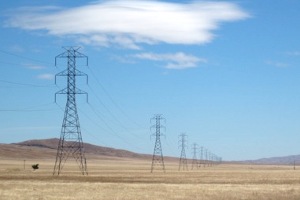[SOUND: car passing]
...a flat triangle of short-grass and scrub, hidden amidst the coast ranges northwest of Fresno. But the valley hasn't escaped everyone's notice.
MIKE PETERSON: I'm Michael Peterson, and I am the CEO of Solargen Energy...
MILLER: To Mike Peterson, Panoche Valley is an oasis between the dust of the Central Valley and the fog of California's coast; a kind of solar Shangri-La, which he says has 90% of the solar potential of the Mojave Desert.
PETERSON: It makes all the difference in the world...because it's how much sun you're capturing and turning into electricity and that's your revenue source.
MILLER: Another part of the valley's allure: a line of transmission towers already marches straight through it, carrying electrons to the densely populated Monterey Peninsula.
PETERSON: When we had an engineer come who'd built a lot of different solar around, he came...we, we took him down to the property. And his comment was, wow. God made this to be a solar farm (LAUGHS).
MILLER: And so with that bit of second-hand Devine guidance, Peterson has been stitching together land deals to create one of the nation's biggest solar power arrays of its kind, in Panoche Valley.
REB MONACO: We're on the radar, so to speak, for solar.
That's Reb Monaco, supervisor of San Benito County whose district includes the Valley. He sees another kind of "solar potential" there.
MONACO: And it's unique, I guess, the surrounding counties don't have the amount of sunlight that our county has. So that asset, from my perspective as a county supervisor, we need to market that asset as effectively as we can.
MILLER: Monaco says he hasn't decided how he'll vote when supervisors are called on to approve the project. But with unemployment stuck at more than 20% in his county and Solargen promising jobs-mostly during the six-year construction phase-the project has his attention.
MONACO: Any job is significant in this day and age, I think.
MILLER: Solargen has marked of a site that would have solar panels on the equivalent of about 4700 [more than 4,000) football fields. Another 12,000 acres or so is what developers call "mitigation land." The company is wending its way through the permitting process, which includes a $1.3 million environmental impact report administered by the county but paid for by Solargen's investors. And from this perspective, the valley may be less oasis than minefield. MIKE WESTPHAL: Actually, we call it a reservoir of endangered species. MILLER: Mike Westphal is an ecologist for the Bureau of Land Management, whose property surrounds the intended Solargen site. WESTPHAL: Everything that seems to have been in the larger San Joaquin Valley seems to still be here. MILLER: That includes about a half-dozen protected species, from foot-long lizards to San Joaquin kit fox. For weeks now a platoon of biologists have been combing the valley floor for signs of endangered or threatened critters, so that Solargen can produce a mitigation plan under California's environmental laws. Westphal is skeptical that this will go quickly. WESTPHAL: Even in projects that only have one of these species, you generally see an environmental review process going on for years before anything happens. The obstacles are huge to getting development here, I don't see a shovel hitting the ground here for years at a minimum. MILLER: But in order to get federal stimulus dollars up front, Mike Peterson will need to break ground here by the end of this year. PETERSON: I actually remember when I came home, and went into the kitchen and I said to my wife, I said, you know, I thought everybody wanted solar. (LAUGHS) MILLER: Not everybody, it would seem. RON GARTHWAITE: This specific one, yes, we don't want it to be here. We're fighting it. [SOUND: Bleating calf]
MILLER: Ron Garthwaite runs the Claravale organic dairy farm in the valley. He stands at the intersection where two well-intended goals are colliding in California.
GARTHWAITE: Even if you're pro solar power, it's just--yeah, when you're taking a place that has agricultural value and natural value and turning it into a solar power plant, it just doesn't make any sense, no.
The BLM's Westphal puts it succinctly.
WESTPHAL: It's like an irresistible force hitting an immovable object.
MILLER: Caught in the middle are more than 200 wind and solar energy projects currently under review in California. Mike Peterson's is just one.
PETERSON: And it's tough. We have California laws that make it very difficult. I could go to Texas and get-pull three permits and have this ready to go in months.
MILLER: As anyone acquainted with California's Environmental Quality Act can attest, this is not Texas. But in order to make the Governor's one-third goal, utilities will have to find some way to at least double the output from renewable energy sources, in the next ten years.
MILLER: This is Craig Miller in San Benito County.
HOST: Next week, we pick up the Panoche Valley story with a closer look at the environmental concerns that confront this large-scale solar project. In the meantime there's a slide show and video of the valley online at KQED.org/33x20.
 The continuing environmental tragedy on the gulf Coast has underscored the peril of continued reliance on fossil fuels. Here in California, the bar has been set high for clean energy, with an ambitious plan to reach 33 percent renewable sources by 2020. Some critics say it's just not possible.
The continuing environmental tragedy on the gulf Coast has underscored the peril of continued reliance on fossil fuels. Here in California, the bar has been set high for clean energy, with an ambitious plan to reach 33 percent renewable sources by 2020. Some critics say it's just not possible.